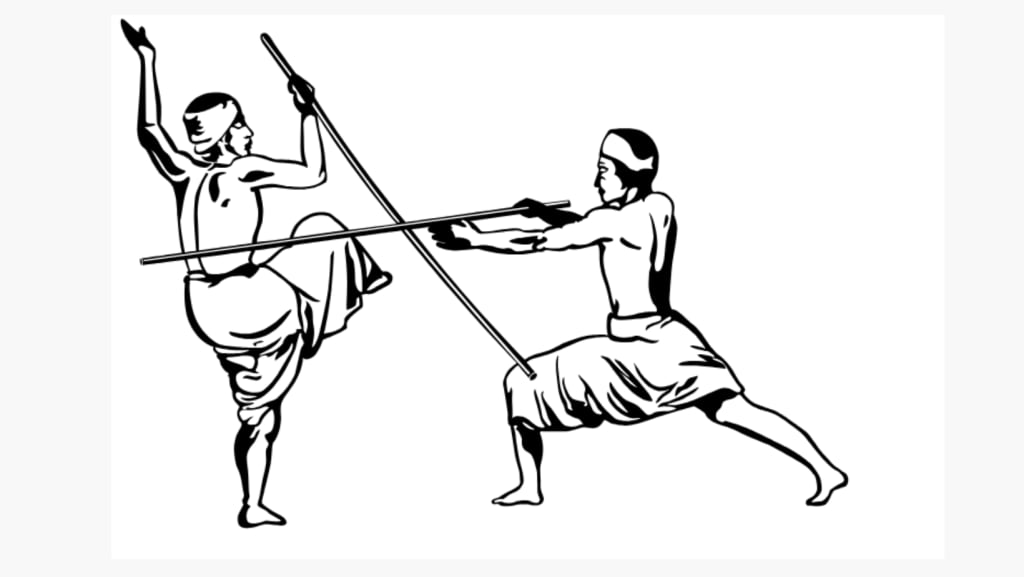
Tamil Silambam, a traditional martial art form originating from the southern state of Tamil Nadu in India, stands as a testament to the rich cultural heritage and martial prowess of the Tamil people. This ancient fighting style, characterized by its graceful movements and the use of sticks, has a history that spans centuries and continues to be a source of pride and fascination in the world of martial arts.
A Glimpse into History
- Tamil Silambam's history can be traced back over 3,000 years, making it one of the oldest martial arts in the world. The term "Silambam" is believed to have derived from the Tamil words "silam" (hill) and "ambu" (bamboo), reflecting its early association with combat techniques in hilly terrain using bamboo sticks.
- Historically, Silambam was not just a form of self-defense but an essential skill for warriors and soldiers. It was passed down through generations, often in secret, to protect the land and its people.
- Over time, it evolved into a respected art form, blending martial skills with dance-like movements.
Techniques and Training
- Tamil Silambam is distinguished by its unique weaponry – long bamboo staffs known as "silambu." These staffs vary in length, and practitioners are trained to use them for both offense and defense.
- The techniques are characterized by fluid and rhythmic movements, making Silambam resemble a dance more than a combat form.
- Varied Techniques: Silambam comprises a wide range of techniques, including striking, blocking, and grappling.
- It involves footwork, spins, and intricate maneuvers, all executed with precision and speed. The emphasis is on agility, flexibility, and timing.
- Empty-Hand Techniques: In addition to the staff, Silambam practitioners are trained in empty-hand combat techniques, such as punches, kicks, and joint locks. These skills provide a well-rounded foundation for self-defense.
- Mastery of Weapons: Silambam training often extends to the mastery of other traditional weapons, including the urumi (a flexible sword) and the valari (a whip-like weapon).
- This versatility ensures that practitioners are well-equipped to handle various combat scenarios.
- Mental Discipline: Silambam places significant emphasis on mental discipline, concentration, and focus. Practitioners learn to remain calm under pressure, a skill that extends beyond the training ground into daily life.
The Significance of Silambam
Tamil Silambam is not merely a martial art; it holds deep cultural and historical significance for the Tamil people. Here are some key aspects of its importance:
Preservation of Tradition: Silambam serves as a living link to Tamil Nadu's rich cultural heritage. It embodies the resilience, bravery, and determination of the Tamil people throughout their history.
Physical Fitness: The practice of Silambam promotes physical fitness, flexibility, and overall health. It encourages a balanced lifestyle and instills values of discipline and commitment.
Self-Defense: In an age where personal safety is paramount, Silambam equips individuals with effective self-defense skills. It empowers both men and women to protect themselves and their communities.
Sport and Competition: Silambam has evolved into a competitive sport, with tournaments and championships held at local, national, and international levels. It has gained recognition on the global stage, attracting practitioners and enthusiasts worldwide.
Challenges and Future Prospects
While Tamil Silambam continues to thrive as a cherished martial art, it faces some challenges in the modern era. One of the main hurdles is the need for increased awareness and promotion, both within India and globally. Efforts to preserve and transmit this ancient art form to future generations are crucial.
Additionally, the standardization of techniques and training methods can help ensure consistency and authenticity in Silambam practice. Collaboration with martial arts organizations and the inclusion of Silambam in international sporting events can further elevate its status.
Conclusion
Tamil Silambam, with its rich history, graceful movements, and effective combat techniques, stands as a testament to the cultural and martial heritage of Tamil Nadu. It is not only a source of pride for the Tamil people but also a valuable martial art form with applications in self-defense, physical fitness, and mental discipline. As efforts to promote and preserve Tamil Silambam continue, it is poised to remain a symbol of tradition, resilience, and grace for generations to come.
About the Creator
Loki
As a content writer, I have a passion for creating engaging, informative, and compelling written content for a variety of industries and audiences...






Comments
There are no comments for this story
Be the first to respond and start the conversation.